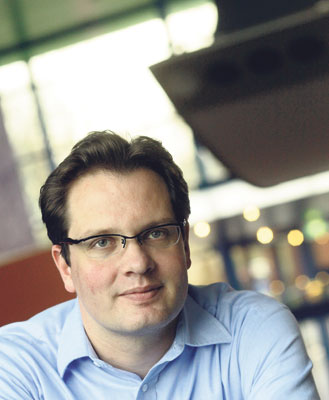I tested our method for the relative positioning between the plane and a reference station at the Nederlands Meet Instituut (NMI) on the Thijsseweg. I could determine precisely where the plane was with the new relative positioning method I’m currently developing.
The current trend is to launch several smaller satellites, acting as a large spacecraft in a so-called formation in space, instead of one big and heavy satellite. It’s very important to know where all the different elements of the mission are. When one wants to determine the relative position of a formation, a dynamic approach is often used. This kind of approach has a reduced performance when the orbit is actively controlled. Moreover, it’s not possible to use this approach to determine the relative position in other applications, such as for example planes flying in formation.
I’m working on a new kinematic approach for relative positioning and the determination of orientation, based solely on observations from Global Navigation Satellite Systems (GNSS) like GPS and Galileo. With the help of these observations, I determine where vehicles, like airplanes or satellites, are located relative to each other. My approach could be used independent of the mission or vehicle, which is an important advantage over the dynamic approach. It could also determine the relative position between airplanes when, for instance, a plane must be fuelled in air or when a plane wants to land on an aircraft carrier. My approach can determine the relative positions up to the centimetre-millimetre level.
We have done several experiments with a ship on the Schie. We put three GPS receivers onboard and another three at the reference station. Using observations from the receivers, we were able to determine the relative position of the ship to the reference station at the NMI. As we used three receivers, we also determined the orientation of the ship. I’ve also tested my method at the European Space Agency (ESA) office in Noordwijk. We simulated a space mission with multiple satellites.
The most spectacular testing of this method is done in Japan. A microgravity research vehicle is dropped from a balloon at an altitude of 40-kilometres. The vehicle is in a freefall and my system determines the relative position and the orientation, which is tricky because of the vehicle’s unpredictable movements.
Within a year I think I’ll be able to demonstrate that this kind of approach works well for different types of applications. But more research will have to be done after I receive my PhD, and therefore I would like to continue to work on it.”
Vorige week kreeg ik een blauwgroene folder in mijn handen geduwd. En net op het moment dat ik hem in de prullenbak wilde gooien zag ik de tekst op de achterkant: ‘Evolutie of Schepping, wat geloof jij?’
Nu geloof ik helemaal niks. En dus zou ik op de lijn van Darwin moeten zitten: als je veel eigenschappen hebt die handig zijn in je leefomgeving, leef je langer en kun je die nuttige eigenschappen ook weer doorgeven aan je nageslacht. The survival of the fittest. Toch denk ik niet dat het in alle gevallen de fittest ook echt survivalt. Of misschien wel fittest, maar niet fitting.
Neem nou de mens. Meer vetcellen dan breincellen. Vetcellen waren uiterst nuttig en noodzakelijk voor de overleving toen we nog bibberend in ons berenvel de winter moesten overleven, kauwend op gedroogd mammoetvlees en halfrotte knollen. Zonder vetcellen had je geen reserves en dus legde je het loodje. Maar twintigduizend jaar later zijn wij geen mammoet-etende Flintstones meer, maar laptopverslaafde pret-snackers. Je zou verwachten dat het menselijk lijf daarop zou zijn aangepast. Maar nee hoor, we hebben nog even veel vetcellen als onze prehistorische voorouders. En daarom nestelt iedere gevulde koek zich binnen een uur op ons bovenbeen.
Om nog even bij de menselijke evolutie te blijven: ik las pas dat er 350 duizend jaar oude speren zijn gevonden. Oftewel: al 350 millennia gebruiken we voorwerpen, en al 350 millennia lopen we dus te hannesen: speer in de ene hand, mand in de andere, en hoe pak ik nou dat konijn op dat ik net heb gespietst. Twee handen zijn gewoon te weinig. Waarom hebben we niet allang een extra handje er bij geëvalueerd? Nu sta ik met mijn vergaderstukken onder mijn oksel, een kop koffie balancerend op de bol van mijn voet, een pen achter mijn oor en mijn pda in mijn mond de deur van mijn kamer open te maken.
Maar zijn ook voorbeelden van uitermate succesvolle evolutie door perfecte aanpassing aan de omgeving. Kijk maar eens naar de huiskat, onze eigen felix domesticus. Tienduizend jaar geleden nog een woestijnbewoner in Klein-Azië maar sindsdien op slimme wijze geëvolueerd tot professioneel huisdier. Energielabel A, gestoffeerd met krimpvast, kleurecht, aaibaar designerbont en zodanig vormgegeven, dat het verzorgingsdrang opwekt bij de mens en dus de kat verzekert van bed and breakfast van wieg tot graf.
Net als de mens heeft ook de kat meer vetcellen dan breincellen. Daar hebben ze helemaal geen probleem mee. Een vetkussentje ligt lekkerder, en de mens is nog meer geneigd tot aaien als je mollig bent. En breincellen houden je maar wakker.
En ze hebben helemaal geen behoefte aan handjes. Als ze handjes hadden, dan zouden wij ze aan het werk zetten, ze opdragen de vloer te boenen tijdens kantooruren of een eenvoudige doch voedzame maaltijd voor de baas te bereiden. Nee, zonder handjes is veel beter, dan heb je tenminste een excuus om acht uur per dag nagelvast op het voeteneind van het grote bed te liggen verharen.
Over functionaliteit gesproken.
Ellen Touw is hoofd van de dienst onderwijs- en studentenzaken bij Civiele Techniek en Geowetenschappen en beleidsadviseur internationalisering.



Comments are closed.